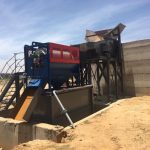
Mining 101: Caledonia annual gold output growth averages 4% in last 5yrs
…as it makes a renewable energy push
By Almot Maqolo
HARARE – Gold production at Caledonia Mining Corporation had an annual average growth rate in output of 4% since 2017, Constructmine has learnt.
Caledonia’s operational asset, Blanket Mine, was purchased on 1 April 2006 with ownership currently amounting to a 64% stake. The gold miner is part of Zimbabwe’s plan to transform the mining industry into a US$12 billion conomy by 2023. Under the plan, the country targets to produce 100 tonnes of gold per year and generate US$4 billion.
The gold miner had a record total gold production during 2021 of 67 476 ounces, exceeding the company’s revised increased guidance and a 17% increase on 2020 annual production. Whilst the firm has decided not to exercise the option to the Glen Hume Mine, analysts say open cast mines Connemara North and Maligreen Goldfields remain on the cards with annual historic output of 20 000 ounces each.
This will be underpinned by completion of the Central Shaft project that commenced in February 2015. The new haft is poised to improve production to 80 000 ounces of gold per annum from 2022 onwards, almost double the level of 2014.
Stiff Covid-19 induced lockdowns – like any other fully established mines, it was granted permission to operate by government after demonstrating that its employees can be quarantined from surrounding areas and ability to reconfigure operations to reduce the risk of the virus being transmitted.

Gold production stood at 55 182 ounces in 2019 compared to 54 511 ounces in 2018. Of the total production, 16 876 ounces were produced in the fourth quarter alone compared to 14 952 ounces in Q4 2018.
From 2018 to 2020, the gold miner spent about US$22.7 million on power consumption but shifted focus to renewable energy for an uninterrupted power supply and reduced costs. Power requirements are expected to more than double in the next few years in line with the country’s ambitious plan to raise mining output and earn the country US$12 billion a year.
The company’s diesel consumption increased by 41% in 2020 due to the generator running-time increasing as a result of a deterioration in the grid supply. Recognising the economic, environmental and logistical challenges of running large-scale diesel generators for extended periods, Caledonia is constructing a 12 MWac solar plant at a cost of $12 million, with an additional $2 million for expenses which includes; designs, tender process, obtaining licences and site clearance.
Blanket Mine uses electricity to power most of the underground equipment and to hoist ore, waste and employees to surface. Electricity is also used to run the metallurgical plant. Meanwhile, Caledonia Mining Corp.’s Blanket mine will spend about US$200 million on renewable energy for an uninterrupted power supply and reduced costs with the capital being raised through untapped markets.
While it is costly, the miner uses diesel-generated electricity to augment power suppliers. On a monthly basis – the company until December was spending US$450 000 on diesel generator costs. But, now it is spending about S$350 000 a month “which is still too much”, according to the miner.

The world is going through profound change in energy and renewable energy has moved to the centre-stage of the global energy landscape.
On the issue of raising more capital, Learmonth said: “We have already done that, we did it. We raised US$7.5 million in November and we are going to need to spend another US$200 million on solar and sadly we will absolutely tap the real markets, London Stock Exchange and Victoria Falls Stock Exchange(VFEX).”
Thanks to a 14% uptick in Q4 2017 as gold output rose 11.4% to 56 133 ounces in FY2017.
Since takeover of Blanket mine in 2006, Caledonia has heavily invested in the sustainability of operations with the view of enhancing business longevity. The business remains highly cash generative with the recent aggressive capex investments funded from internally generated cash flows to a tune of US$67 million.
The gold miner offers an attractive dividend policy, disbursed and reviewed quarterly in hard currency. It is now focusing on becoming a multi-asset gold producer as part of its growth strategy.However, the return of high inflation, a rapidly depreciating local currency and serious energy supply problems is likely to have a material effect on the company’s operations.
Also all eyes would be on the incoming chief executive officer Mark Learmonth who will replace Steve Curtis. Aged 65, Curtis has been the company’s CEO for 7 years but will retire from his role with effect from 30 June 2022. The new CEO will keep the market guessing whether he will ring any new changes or continue from where his predecessor has left.
The return of high inflation, a rapidly depreciating local currency and serious energy supply problems, market watchers are of the view that is likely to have a material effect on the mine’s operations.


